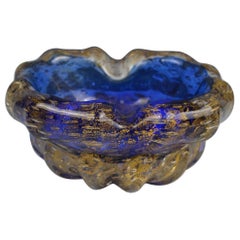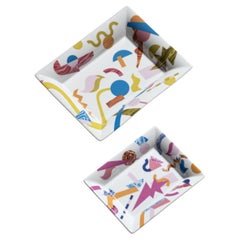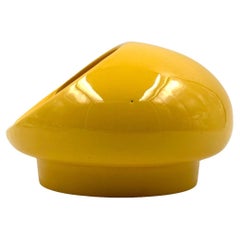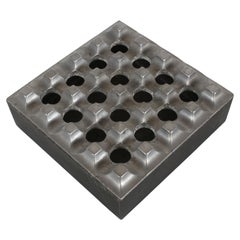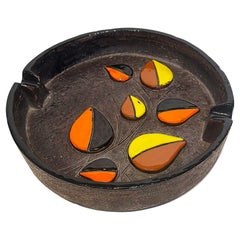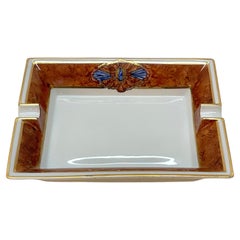European Ashtrays
to
451
1,841
108
3
2
12
1,827
111
60
1,062
552
4
2
23
60
49
226
289
305
45
10
1,082
131
85
58
34
9
8
5
5
2
2
1
1
1
895
544
542
377
307
1,385
440
1,952
1,213
279
267
230
1,952
1,896
1,920
43
38
34
32
31
Place of Origin: European
Murano glass ashtray with 24 carat gold flecks
Located in Marinha Grande, PT
Murano glass ashtray made with cobalt blue glass fused with 24 carat gold flecks.
Very nice piece
Category
1950s Mid-Century Modern Vintage European Ashtrays
Materials
Gold
Alchimie Contemporary Porcelain Pocket Emptier, Two Sizes, by Vito Nesta
By Vito Nesta
Located in Milano, Lombardia
Il set comprendente svuota tasche e posacenere di Grand Tour by Vito Nesta è un binomio vincente per ogni tipo di ambiente. Ottimi in ingresso, su un tavolino in salotto, una mensola...
Category
2010s European Ashtrays
Materials
Porcelain
Space age yellow ceramic ashtray, Viba Italy 1970s
Located in Firenze, IT
Space age yellow ceramic ashtray
Viba Italy 1970s
H: 11.5 cm - 20 cm diam.
Labelled on the base
Conditions: excellent, no defects
Category
1970s Space Age Vintage European Ashtrays
Materials
Ceramic
Mid-Century Op-Art Aluminum Ashtray Ultima15 by Backström & Ljungberg Sweden
By Holger Bäckström & Bo Ljungberg
Located in St. Louis, MO
Mid-Century Modern geometric Op-Art Beck & Jung aluminum ashtray "Ultima15" designed by Bo Ljungberg & Holger Backström for Diverse Ting, Malmö Sweden. All Aluminum construction, wit...
Category
1960s Scandinavian Modern Vintage European Ashtrays
Materials
Aluminum
Mid-century Modern Bitossi Ceramic Ashtray, Marked, 2 Available
By Bitossi
Located in Miami, FL
Mid-century Modern Bitossi Ceramic Ashtray, Marked, 2 available
Offered for sale is a brown ceramic Bitossi ashtray or catchall accented with orange, yellow, brown and blacks leaves...
Category
Mid-20th Century Mid-Century Modern European Ashtrays
Materials
Ceramic
Limoges Midcentury Hand-Painted by Cevoli White Porcelain French Ashtray, 1980s
By Limoges
Located in Roma, IT
Amazing midcentury Limoges hand-painted white porcelain ashtray. This fantastic piece was hand-painted by Giulia Lucente Cevoli in Italy during the...
Category
Mid-20th Century Mid-Century Modern European Ashtrays
Materials
Ceramic, Porcelain
Vintage Italian Ashtray Hand Blown 1960s
Located in Los Angeles, CA
Italian handmade ashtray, the ashtray has a handprint in the center which looks very beautiful and rare.
Category
1960s Mid-Century Modern Vintage European Ashtrays
Materials
Art Glass
20th Century Amazing, Modern, French Faceted Ashtray in Baccarat Crystal
By Baccarat, Cristalleries De Baccarat
Located in Catania, IT
20th century amazing, modern, French Faceted ashtray in Baccarat Crystal.
Precious French faceted crystal ashtray signed Baccarat original lab...
Category
1980s Vintage European Ashtrays
Materials
Crystal
$672 Sale Price
20% Off
Mid-Century Floor Standing Ashtray signed by Castiglioni for Zanotta, Italy 1957
By Achille & Pier Giacomo Castiglioni, Zanotta
Located in Roma, IT
An iconic piece of Italian design, this elegant freestanding ashtray was designed by the Castiglioni brothers for Zanotta in 1957. A perfect example of functionality and material exp...
Category
Mid-20th Century Mid-Century Modern European Ashtrays
Materials
Metal, Steel
1980s Modernist Blue and Brown Murano Glass Triangular Ashtray
By Seguso
Located in Aci Castello, IT
A perfect condition blue and brown murano glass ashtray manufactured in Venice in the Eighties. The Triangular Ashtray is a beautifully crafted and visually striking piece. Its uniqu...
Category
Late 20th Century Modern European Ashtrays
Materials
Murano Glass
Dino Martens ashtray in Murano glass circa 1950
By Dino Martens
Located in Rio De Janeiro, RJ
Ashtray in Murano glass by DINO MARTENS to Aureliano Toso
Category
1950s Mid-Century Modern Vintage European Ashtrays
Materials
Murano Glass
Italian Marble Ashtray Catchall, Large
Located in New York, NY
A substantial and relatively large Italian black and white marble catchall ashtray in the Modern style Postmodern period, circa late-20th century, 1970s, Italy. Piece has a polished ...
Category
Late 20th Century Modern European Ashtrays
Materials
Marble
Mid-Century Czech Ashtray, Hand-Formed Art Glass, c. 1960s
By Josef Hospodka
Located in Praha, CZ
A stunning mid-century modern ashtray made of heavy Bohemian art glass using the sommerso technique. Hand-shaped in Czechoslovakia in the 1960s, this piece features bold, layered col...
Category
1960s Mid-Century Modern Vintage European Ashtrays
Materials
Glass
Set of Two 1980s White Porcelain Horse Ashtrays by Gucci Firenze
By Gucci
Located in Aci Castello, IT
This is a Set of Two White Porcelain Horse Ashtrays by Gucci Firenze, circa 1980s. The ashtrays feature a clean, glossy white finish and are elegantly crafted in square shapes with s...
Category
Mid-20th Century Modern European Ashtrays
Materials
Porcelain
Handcarved Pipe for Savinelli
By Savinelli design
Located in Sagaponack, NY
A hand carved wood smoking pipe, the handle circled by a silver band with etched decoration. Marked "Estella 316 EX".
Category
1940s Mid-Century Modern Vintage European Ashtrays
Materials
Metal
Set of 2 Colorful Murano Glass Ashtrays Mid-Century Italian Design 1960s
Located in Palermo, IT
Set of 2 of colorful Murano glass ashtrays Mid-Century Italian design 1960s
Good condition, very small scratches and defects.
Category
1960s Vintage European Ashtrays
Materials
Murano Glass
Cohiba Special Edition 30th Anniversary Cigar Ashtray
Located in Hanover, MA
Cohiba Special Edition 30th Anniversary cigar ashtray made of porcelain with 14k gold detail.
Produced by Porcelanas Bidasoa for the Cohiba 30th anniversary party in the Tropicana i...
Category
1990s Art Deco European Ashtrays
Materials
Porcelain
Vide Poche in Alabaster from Italy 1960, in White Color, Large Size
Located in Auribeau sur Siagne, FR
Vide Poche in Alabaster from Italy 1960, in White Color, Large Size
Category
1960s Hollywood Regency Vintage European Ashtrays
Materials
Alabaster
$432 Sale Price
20% Off
Collectible White Porcelain Ashtray Hotel Intercontinental Paris France 1950's
Located in North Hollywood, CA
Collectible Ashtray Intercontinental Paris le Grand Hotel France.
From the InterContinental Paris le Grand Hotel France, collectible.
Ivory white ceramic with gold Imperial crown logo and inscriptions.
A cream crackled ceramic ashtray with gilt edge from the Intercontinental Hotel in Paris, France.
Manufactured by Bausher Weiden Bavaria white Porcelain Germany...
Category
Mid-20th Century Napoleon III European Ashtrays
Materials
Ceramic
Murano Crystal Glass Sommerso Ashtray in two colors by Seguso, 1950, Italy
By Seguso Vetri d'Arte, Flavio Poli
Located in Morazzone, Varese
Gorgeous and incredible beautiful big ashtray attributed to Flavio Poli for Seguso Vetri d’Arte, handcrafted in the tradition of the major manufacturers of...
Category
1960s Mid-Century Modern Vintage European Ashtrays
Materials
Art Glass, Murano Glass
Martini & Rossi Italian Ceramic Ashtrays - a Pair
Located in Bradenton, FL
A pair of French Martini & Rossi triangular ceramic ashtrays. White ceramic reads "Martini & Rossi, Red or Extra Dry on the rocks" on each side. Each corner has a beveled cigarette r...
Category
Mid-20th Century European Ashtrays
Materials
Ceramic
Tobacco Set in Travertine Ashtray Lighter and Box by Cerri Nestore, Italy, 1970s
By Cerri Nestore
Located in Rome, IT
Tobacco set in travertine marble composed of ashtray, lighter and box by the Italian designer Cerri Nestore, 1970s.
The original label is still attache...
Category
1970s Mid-Century Modern Vintage European Ashtrays
Materials
Travertine, Marble
Elegant 1970s Breccia Marble Ashtray/Small Tray, Warm Gray and Rust Tone
Located in Bagnolo Mella, Brescia
This exquisite ashtray or small tray, crafted from Breccia marble, is a timeless piece that captures the elegance of the 1970s. The marble features a stunning array of warm, earthy t...
Category
1970s Mid-Century Modern Vintage European Ashtrays
Materials
Breccia Marble
Murano Glass "Strawberry" Bowl Element Shell Ashtray Seguso Murano, Italy, 1970s
By Seguso Vetri d'Arte
Located in Kirchlengern, DE
Article:
Murano glass bowl, ashtray element
Origin:
Murano, Italy
Producer:
Seguso Dalla Venezia (SDV) see label sticker.
...
Category
Late 20th Century Mid-Century Modern European Ashtrays
Materials
Murano Glass
$624 Sale Price
20% Off
Gallotti & Radice Ashtray Piece Often Crystal Glass Metal Structure 1970 Italian
By Gallotti & Radice
Located in Palermo, Sicily
Gallotti & Radice ashtray piece often crystal glass metal structure, 1970, Italian.
Category
1970s Mid-Century Modern Vintage European Ashtrays
Materials
Crystal, Metal
Carl Auböck Butler Ashtray in brass for Illums Bolighus, 1950s
By Werkstätte Carl Auböck
Located in Esbjerg, DK
Eleganty crafted Brass ashtray with stylized walnut handle designed by Carl Aübock and produced under license by Illums Bolighus in the 1950’s. It was an expensive item in the 1950s ...
Category
1950s Mid-Century Modern Vintage European Ashtrays
Materials
Brass
Pair of Midcentury Concorde & DC-8 Desk Model Airplane Chromed Ashtrays
Located in Barcelona, ES
Pair Mid-Century Modern Chromed Steel Concorde and DC-8 Plane Ashtrays, Spain, 1950s-1960s
The set is comprised by a French Concorde and a Douglas DC-8 from spanish airline Iberia.
They were made of chromed metal and produced in Spain.
Manufacturer's stamo underneath
Nice choice for any aviation collector and great as a gift idea.
On sale as a pair.
Measures:
The Concorde: 24,5 cm W x 14,5 cm D x 12 cm H
DC-8 Iberia Airlines: 24 cm W x 17 cm D x 12,5 cm H
Pair of Midcentury Flight Souvenir Airplane Ashtrays...
Category
Mid-20th Century Mid-Century Modern European Ashtrays
Materials
Metal, Steel, Chrome
Italian Mid-Century Ashtray in Murano, Steel and Brass, Italy, 1950s
Located in Barcelona, ES
Ashtray made of steel structure and Murano glass, the ring where the glass fits and the top handle are in solid brass. Original condition.
Category
1950s Mid-Century Modern Vintage European Ashtrays
Materials
Brass, Steel
Vintage Guilloche Gilt Ashtrays, Enamel Ashtrays - Set of Three - Denmark, 1960s
By David Andersen
Located in Bochum, NRW
Vintage Guilloche Gilt Ashtrays, Enamel Ashtrays - Set of Three - Denmark, 1960s. In the style of David Andersen.
Very good overall condition, minimal wear of time.
Dimensions: 6.5x5...
Category
1960s Mid-Century Modern Vintage European Ashtrays
Materials
Metal, Enamel
Ceramic ashtray with play card motivs france around 1960s
Located in Wien, AT
Ceramic ashtray with play card motivs france around 1960s
Original condition
Category
1960s Mid-Century Modern Vintage European Ashtrays
Materials
Ceramic
Bitossi Aldo Londi Rimini Blue Glazed Ceramic Large Square Ashtray
By Bitossi, Aldo Londi
Located in Barcelona, ES
Signed Large Rimini blue Mid-Century Modern ashtray. It has 3 cigar or cigarette holders and it is made in blue glazed terracotta ceramic, designed by Aldo Londi and manufactured by ...
Category
Mid-20th Century Mid-Century Modern European Ashtrays
Materials
Pottery, Terracotta, Ceramic
Murano Glass Bowl with Copper and Ruby Aventurine
By Vintage Murano Gallery
Located in Soquel, CA
Beautiful clear centerpiece bowl / ashtray with copper aventurine and burgundy streaks in web design. Indistinct Murano label (signed). Size: 3"W x 1...
Category
1970s Mid-Century Modern Vintage European Ashtrays
Materials
Art Glass, Blown Glass
Smile Ashtray from Carl Cohr, 1950s
Located in Esbjerg, DK
Egg shaped stainless steel ashtray. Very rare in this metal composition - brushed stainless. It is called the smile and was designed by Hans Bunde and manufactured by Carl Cohr in Fr...
Category
1950s Mid-Century Modern Vintage European Ashtrays
Materials
Stainless Steel
$360 Sale Price
20% Off
Large Vide Poche or Ashtray in Glass, Geometrical Patterns France, circa 1970
By Jacques Adnet
Located in Auribeau sur Siagne, FR
This vide poche or ashtray in in Glass. It has been done circa 1970, in France.
Transparent Color.
Category
1970s Vintage European Ashtrays
Materials
Art Glass
$432 Sale Price
20% Off
Leather Armrest Ashtray and brass Mid-Century Modern Italy 1970s
Located in Palermo, IT
Armrest ashtray in soft black leather. In the centre, the brass ashtray. Used piece with signs of wear over time. Intact. Please watch the video and photos carefully, thank you.
Le...
Category
Mid-20th Century Mid-Century Modern European Ashtrays
Materials
Brass
French White Porcelain Jewelry Tray Catchall Vide-Poche or Ashtray
By Hermès
Located in New York, NY
A French white porcelain tray vide-poche (catch-all) or ashtray, circa mid to late-20th century, France. A great standalone piece or tray to hold ...
Category
Mid-20th Century European Ashtrays
Materials
Porcelain
$380 Sale Price
20% Off
Large Cylinda-Line Brass Cigar Ashtray by Arne Jacobsen, 1960s
By Arne Jacobsen
Located in Esbjerg, DK
This brass version of the Cylinda-line ashtray was designed by Arne Jacobsen and made in a limited run in 1967. This, the large version or cigar ashtray, is by far the rarest of the ...
Category
1960s Mid-Century Modern Vintage European Ashtrays
Materials
Brass
$859 Sale Price
20% Off
Limoges France Dish in Royal Blue with Fragonard Couple and Fine Gold Metal Trim
By Limoges, Cristalleries De Sevres
Located in North Hollywood, CA
Limoges France Dish in Royal Blue with Fragonard Couple and Fine Gold Metal Trim.
Elegant fine vintage Limoges porcelain with 22-karat gold painted trinket small dish vide poche catchall.
French vintage Limoges dish in cobalt royal blue with fine gold trim and handles.
The cobalt blue, rectangular shaped dish features a country scene with a courting couple after the Fragonard 19th...
Category
Mid-20th Century Louis XIV European Ashtrays
Materials
Gold Plate, Brass
Large Murano Amethyst Color And Bubble Design Ashtray or Candy bowl
By Vintage Murano Gallery
Located in Boynton Beach, FL
Large scale Murano glass ash tray or candy bowl. Made in the 1970s in Italy. High artisan Murano hand blowing techniques making a striking organic form. Tiny bubble float evenly insi...
Category
Mid-20th Century Mid-Century Modern European Ashtrays
Materials
Blown Glass, Murano Glass
Two marble ashtrays Italy 70s Mid-Century Modern
Located in Palermo, IT
Two very beautiful ashtrays in red Alicante marble. They have the shape of a turtle. The measurements are for a single ashtray. They also work well as decorative objects. Please watc...
Category
Mid-20th Century Mid-Century Modern European Ashtrays
Materials
Marble
Ceramic Dish Ashtray or Centrepiece in Ceramic 19th Century Malicorne
Located in Auribeau sur Siagne, FR
Malicorne 19th century ashtray or centrepiece.
In the manner Rouen faiences.
Category
19th Century French Provincial Antique European Ashtrays
Materials
Ceramic
$144 Sale Price
20% Off
Multicolor Murano Glass Bowl Gold Flakes Shell Ashtray Dino Martens Italy, 1960s
By Dino Martens, Aureliano Toso
Located in Kirchlengern, DE
Article:
Murano glass bowl, ashtray element, GOLD FLAKES.
DINO MARTENS FOR AURELIANO TOSO, 1960s
Origin:
Murano, Italy
Decade:
1960s
This original glass sh...
Category
Late 20th Century Mid-Century Modern European Ashtrays
Materials
Murano Glass
1970s Enzo Mari for F.lli Mannelli Smoking Set. Made in Italy
By Fratelli Mannelli
Located in Milano, IT
1970s Gorgeous smoking set by Enzo Mari for F.lli Mannelli in travertine and brass with ashtray and table lighter, everything is handmade carved. Made in Italy. The table lighter wor...
Category
1970s Mid-Century Modern Vintage European Ashtrays
Materials
Travertine
Solid Ashtray Made of Hand-Carved Crystal
Located in Marbella, ES
Solid ashtray made of hand-carved crystal.
Category
Late 20th Century European Ashtrays
Materials
Glass
$336 Sale Price
20% Off
Hand-Painted Italian Metal Tray for Table or Wall, With Base
Located in Alessandria, Piemonte
Tuscan hand-painted metal tray, paired with other similar tray - Unusual on wall - On disposal a metal black base (only one with a good price, but there is shipping!).
O/327.
Category
1980s Beaux Arts Vintage European Ashtrays
Materials
Metal
$900 Sale Price
50% Off
Seguso Murano Gold Flecks Ruby Red Italian Art Glass Bowl
By Archimede Seguso
Located in Barcelona, ES
Eye-catching hand blown Murano Burgundy red, gold flecks and controlled bubbles art glass bowl or ashtray. Attributed to Archimede Seguso, ...
Category
Mid-20th Century Mid-Century Modern European Ashtrays
Materials
Gold Leaf
Ashtray or Vide-Poche in Rimini Blue Ceramic, Bitossi by Aldo Londi, Italy 1960s
By Bitossi, Aldo Londi
Located in Roma, IT
Gorgeous ceramic ashtray or vide-poche in a stunning blue glazed (Rimini Blu) color. This vibrant ceramic item was designed by Aldo Londi and hand-craf...
Category
1960s Mid-Century Modern Vintage European Ashtrays
Materials
Pottery, Ceramic
Kosta Boda Clear Round Rurik Textured Ashtray
By Kosta Boda
Located in East Quogue, NY
Stunning Mid-Century Modern Scandinavian 1950s Kosta Boda Rurik clear round textured ashtray in great vintage condition. No chips or cracks.
Glass has a nice weight to it —minimal ...
Category
1950s Modern Vintage European Ashtrays
Materials
Glass, Art Glass
Original 1956 ÖBB ' Österreichische Bundesbahnen' Ashtray by Josef Hoffmann
Located in Vienna, AT
In this ad you can find a beautiful historical artifact. The object for sale is an aluminum cast board ashtray used on Austrian trains in the 50s. It as manufactured for the staatlic...
Category
Mid-20th Century Mid-Century Modern European Ashtrays
Materials
Aluminum
Art Deco Striped Marble Ashtray
Located in San Diego, CA
Art Deco striped marble ashtray circa 1940s. The piece is in good vintage condition (a couple of small ships on the edge-please see pictures) and has a ...
Category
Early 20th Century Art Deco European Ashtrays
Materials
Marble
$220 Sale Price
20% Off
Jacques Adnet Cognac Leather and Glass Ashtray, 1950s France
By Jacques Adnet
Located in Los Angeles, CA
Classic leather and glass catchall / ashtray by French designer Jacques Adnet. Rich cognac leather base with signature Adnet contrast stitching and a circular inset cutout. Crystal g...
Category
1950s Vintage European Ashtrays
Materials
Leather, Glass
Diminutive Vintage Italian Modernist Periwinkle Textured Ashtray by Raymor
By Raymor
Located in Brooklyn, NY
Petite Raymor textured ashtray with swaths of periwinkle, blue, orange, and red over an unglazed, almost faux-bois appearing base (ca. 1960s, Italy).
Some of the rectangles are incom...
Category
1960s Mid-Century Modern Vintage European Ashtrays
Materials
Ceramic
Vintage Clear Acrylic Vase, Italy
Located in Munich, DE
Italian Design Piece.
Category
Mid-20th Century Mid-Century Modern European Ashtrays
Materials
Acrylic
1.7kg Murano Glass "RED-YELLOW" Bowl Element Shell Ashtray Murano, Italy, 1970s
By Alessandro Mandruzzato, Flavio Poli
Located in Kirchlengern, DE
Article:
Murano glass bowl, ashtray element
Origin:
Murano, Italy
Decade:
1970s
This original vintage glass bowl element, ash tray was produced in the 1970s in Murano, Ital...
Category
Late 20th Century Mid-Century Modern European Ashtrays
Materials
Murano Glass
Murano glass ashtray italy around 1970s
Located in Wien, AT
Murano glass ashtray italy around 1970s
Original condition
Category
1970s Mid-Century Modern Vintage European Ashtrays
Materials
Murano Glass
Cristal Benito, No 54 - Facet Cobalt, Handcut Crystal Ashtray, France, 2023
By Cristal Benito
Located in New York, NY
Franck Benito begins his process by tracing his designs onto uncut forms. These are then milled by hand, and the rough cut refined—the patterns channeled deeper and deeper, to the ve...
Category
2010s European Ashtrays
Materials
Crystal
Original blue murano glass ashtray, Italy, 1980s
Located in Miklavž Pri Taboru, SI
Vintage blue murano glass ashtray made in Italy in the 1980s.
The bowl is in very good vintage condition.
Dimensions:
Width: 11 cm / 4.33 inches
Height: 6 cm / 2.36 inches
Weight: ...
Category
Mid-20th Century Mid-Century Modern European Ashtrays
Materials
Murano Glass
$374 Sale Price
20% Off
Mid Century Blue Crystal Glass Ashtray, Italy, 1970s
Located in 05-080 Hornowek, PL
This original vintage glass ash tray bowl element was designed and produced in the 1970s in Lombardia, Italy. It is made in Crystal Cut Technique and has a fantastic faceted form. Th...
Category
Mid-20th Century European Ashtrays
Materials
Glass, Murano Glass
$96 Sale Price
20% Off
1960s Stunning Murano Ochre Ashtray or Catchall by Flavio Poli
By Flavio Poli
Located in Milano, IT
1960s Stunning Ochre ashtray or catchall in Murano sommerso glass by Flavio Poli for Seguso. Made in Italy
No chips or other, this item is perfect in excellent condition.
Dimensions:...
Category
1960s Mid-Century Modern Vintage European Ashtrays
Materials
Murano Glass
Valentino Amber Vide Poche Change Tray or Ashtray
By Valentino Garavani
Located in Los Angeles, CA
Valentino Home amber square lead glass crystal vide poche, change tray, pocket emptier or ashtray / made in Italy
Original label on the glass / comes in original box
Width 5 inches, ...
Category
Late 20th Century European Ashtrays
Materials
Glass
$315 Sale Price
30% Off
